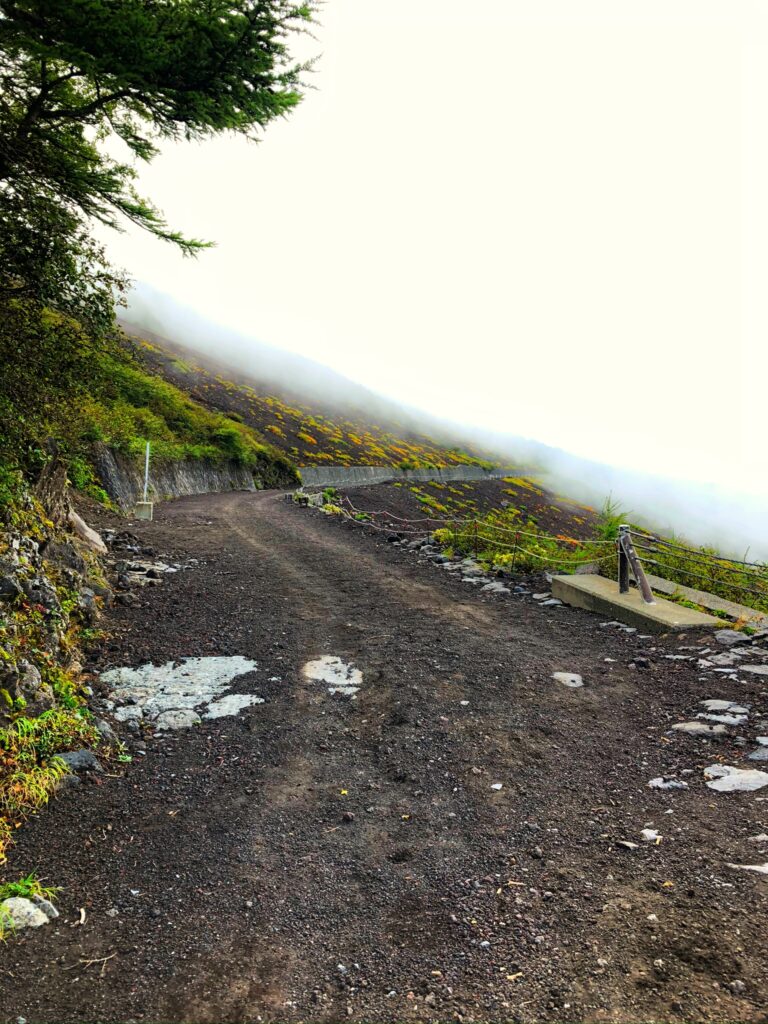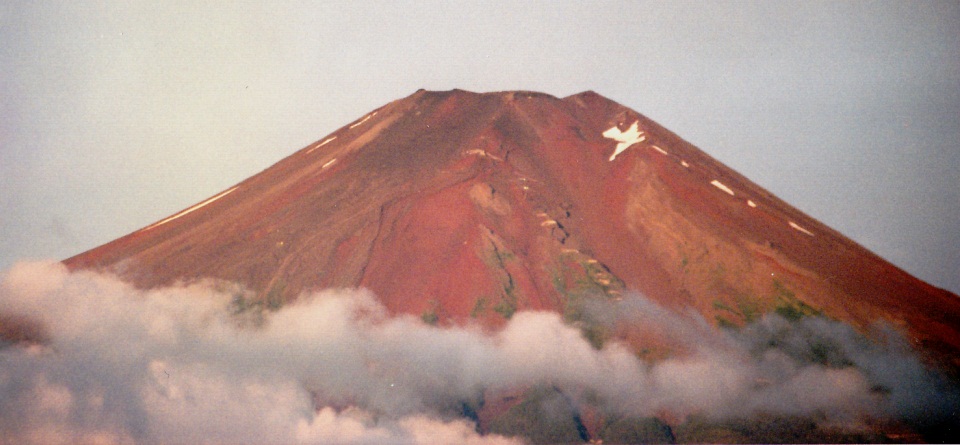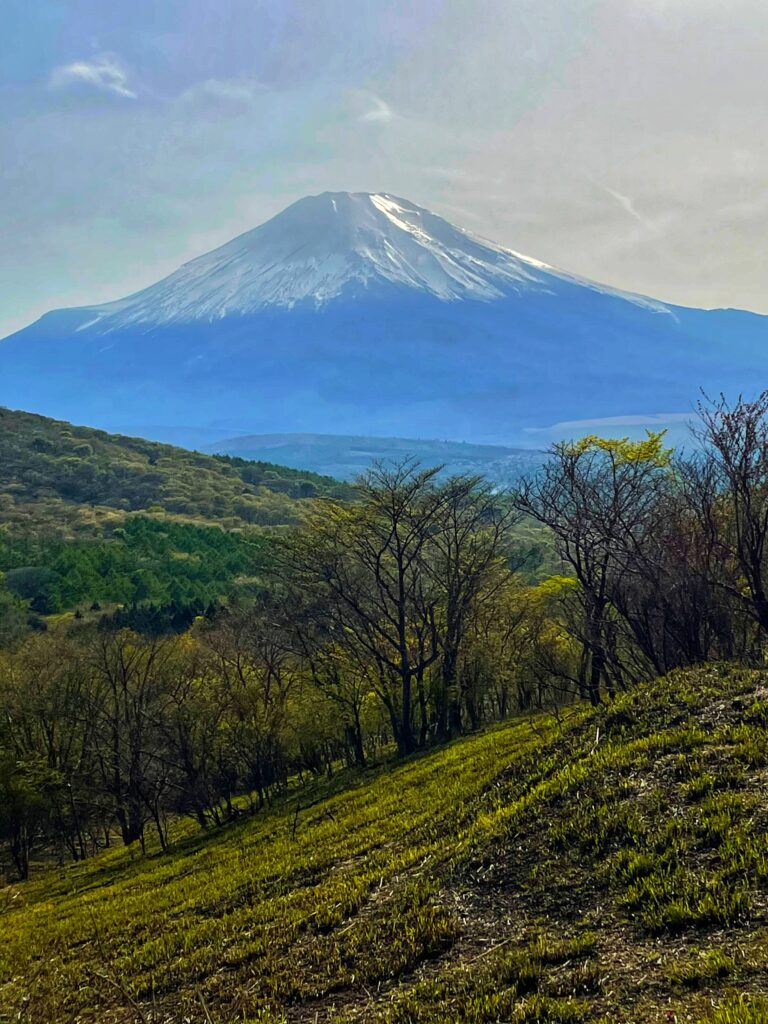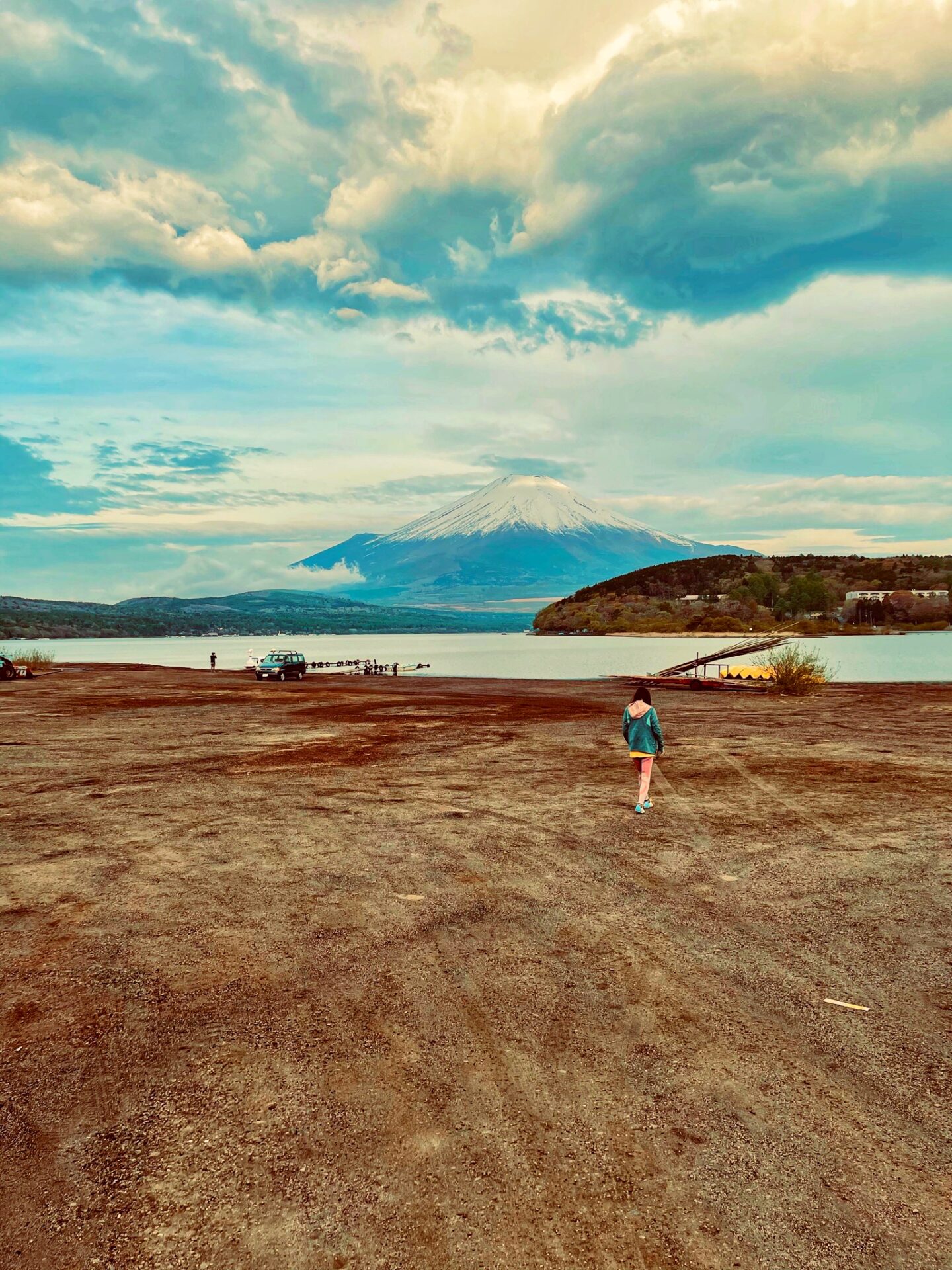The mountain in the city
Even Tokugawa Ieyasu himself had accepted Mt. Fuji was a “cosmic mountain” — up to a point. In this, in addition to seeing Mt. Fuji as at least a sacred mountain, he was accepting the principles of Chinese Feng-shui that said natural features such as mountains exerted tremendous energy that, when building a castle or a city (he built both at the same time with Edo), needed to be harnessed in the right way.
As a result, when Ieyasu ordered the construction of his massive castle in the heart of the city, its designers took into account the giant volcano due west of it.
The sprawling gardens of the city’s aristocratic residents, meanwhile, generally had little “hills” heaped up in them from which to view the mountain — all the better to help them appreciate, or perhaps even indulge in composing, the numerous poems and pictures dedicated to the mountain. Even now, Tokyo is full of locations called fujimizaka, or Fuji-viewing slope, where these gardens were once located, even though the mountain is now blocked off from view in most cases by high-rise buildings.

But Mt. Fuji, or the view of the mountain, was more integral to the city than even this suggests. Even after one and a half centuries of civil war, Japanese cities had never adopted city walls and thus were not enclosed spaces.
In fact, those, like Edo, which were castle towns, might be better thought of as spinning outwards from that central castle, as being centrifugal rather than centripetal. They also differed markedly from their premodern European counterparts in lacking squares — spaces that might be seen as public, or civic.
So what held them together? One Japanese urban geographer has suggested that the people of Edo considered Mt. Fuji, or rather places in the city to view it, as the “common space,” since many of the major streets were laid out to point directly at it, and its silhouette would greet them as they emerged onto these main arteries from the narrow lanes where many of them lived.
Visually then, Mt. Fuji was one of the axes on which Edo was laid out. It is perhaps no surprise that almost 20 of the total of 120 woodblock prints considered to form Hiroshige’s famous “One Hundred Views of Edo” contain the great volcano, often anchoring the entire composition.
Leaving the mundane world
As we climbed further up the mountain, the eerie feeling of the forest and lower slopes gradually gave way to something like elation as glorious views began to unfold and we felt ourselves starting to leave the mundane world behind. It got K and I into the mood to try to describe the “cosmic energy” of the mountain ourselves.
It’s a strange way to think in the 21st century, of course, but the sense of leaving the mundane world behind did really begin to grow on us. In fact, this feeling, common to climbing to high altitudes in general, is no doubt the main reason why, over history, mountains have attracted religious attention — if, that is, the culture is receptive to it. In India and much that lies east of it, including China, Japan and the Korean Peninsula, mountains, or some of them anyway, have long been held to be sacred and the abode of divinities.

K and I agreed that Mt. Fuji’s energies had appeared to us as both positive and negative; as uplifting and somewhat unsettling, too.
With regard to the latter, of course, if we had been more level-headed, rather than getting mystically inclined ourselves, we would probably have admitted that the forest, and the few ruins we passed, had exerted a more melancholy influence that day than they might otherwise have done because of the almost total absence of people.
Nevertheless, when it comes to volcanos, the sense of awe that mountains can provoke is often accompanied by something different — something darker emerging out of the danger that active volcanos present. The Romans, for instance, located the entrance to Hades in a volcanic crater near Naples. Medieval Icelanders also thought hell lurked beneath one of their volcanos.
And indeed, with the exception perhaps of the Orthodox monastery-studded “Holy Mountain” of Athos in Greece, mountains in general were viewed by the Europeans of the past, at least from the start of the Christian era, with fear rather reverence.
Crossing them was seen as a great trial, their presence perhaps a punishment from God. The ancient Greeks might have sited their gods on Mt. Olympus, but for medieval Europeans, mountains were the abodes of dragons and bandits rather than anything holy.
A duality of heaven and hell is present from the earliest days of religious reverence of Mt. Fuji, Earhart notes. For instance, the head Sengen shrine south of Mt. Fuji (which also claims the top of the mountain as part of its shrine grounds), was built at the point where the lava flow from one of its eruptions (the volcano has only been dormant since the 18th century) stopped, but also where there is a large spring of pure water bubbling up from under the mountain.
In other words, it was a site chosen in recognition of both the need to propitiate Mt. Fuji (or its deity) but also acknowledge its bounties. It recognized both positive and negative forces in the mountain.
Moreover, at the time Kakugyo entered Hitoana many centuries later, the cave was being seen by some as the site of a Buddhist hell, even as Mt. Fuji’s summit was being seen as the site of a Buddhist heaven. In a popular medieval tale about Hitoana, Sengen Bosatsu acted not as the revealer of the true cosmic order, but, initially in the form of a snake, as a kind of tour guide to the hellish horrors within.
And indeed, it is all too easy to think of Mt. Fuji as having a kind of “heaven” on its summit and “hell” at its foot.
The hikers could be seen as spiritual heirs of the pilgrims, eagerly seeking a transformative experience, albeit in the secular form of seeing a magical sunrise at what feels like the top of the world.
And the despairing souls heading into the remote parts of the jukai at the bottom could also be thought of as the pilgrims’ spiritual heirs, if one imagines that a few of those pilgrims came to the mountain not so much for enlightenment but in desperation for divine help out of some or other terrible misfortune.
In fact, the “hell” at Mt. Fuji’s foot has been more extensive even than the jukai suicide spot. The Aum Shinrikyo cult, responsible for the 1995 Tokyo subway sarin attack and other atrocities, occupied a series of buildings just beyond the edge of that part of the jukai in a remote village called Kamikuishiki for almost a decade.
Does some negative energy really lurk there?
Well, one has to point out that the area only became a well-known suicide spot in the 1960s, and that before the late 1980s, there was no Aum. It’s really just half a century of “hellish” history. What there was instead was a trackless expanse that people felt wary of entering; a vast, silent, spooky realm of trees. A kind of dark energy? Perhaps.
Red Fuji
Almost six hours after starting, climbing to a height of some 7,500 feet and covering a distance of 13 miles, we finally reached the halfway point beyond which we were not allowed to ascend any further.
If I’ve managed to evoke any kind of atmosphere so far, I’m about to destroy it by saying that we reached a road, from which we caught a bus back to Tokyo. Yes, there’s a road that goes halfway up the mountain! In fact, this is the starting point for most hikers. To reach the summit (12,390 feet) all the way from the bottom is too daunting a prospect for most.
It’s certainly a natural boundary, for from this point the remaining tree cover falls away, and one enters a moonscape of red volcanic rock.

That redness comes as rather a shock to someone who has only seen the mountain from far away. In fact, I had seen “ukiyo-e” woodblock prints of “red Fujis,” the most famous of which is a print by Hokusai that forms part of his “Thirty-Six Views of Mt. Fuji,” but thought it was just artistic license. It’s not. Close up, it really does look like a red mountain, although certain errors in other depictions by Hokusai of Mt. Fuji lead people to suspect he never actually climbed the mountain.
The colour of Mt. Fuji, in fact, has been an obsession for Japanese artists (and photographers), for the mountain is notoriously changeable in this respect, depending on the time of day, the season and the distance from which it is depicted. (It’s not the only prism for viewing it, though; another one is viewing it in conjunction with something else. The most famous example of this might be Hokusai’s “Great Wave Off Kanagawa.”)

On the mountain, the other-worldly feel the terrain acquires at this point where the red landscape begins is intensified by clouds periodically moving in and enveloping one in thick mists. According to Earhart, the pilgrim, having just left the mundane world behind, is ready to enter “death” for the long arid climb up before achieving “rebirth” and “enlightenment” at the summit.
We could only speculate, of course, about that climb to the summit, and exactly how it might have felt to the pilgrim. But we discovered on a trip to a local Mt. Fuji museum the following day that odd things can happen to intensify the religious experience — under certain rare circumstances of the angle of light and cloud cover and where one is standing, one can see one’s shadow in the clouds facing one, as if (according to pilgrims’ accounts) one was encountering a buddha or god as a radiant figure approaching you.
Throw in the other-worldly landscape, one’s own hopes and expectations and those of all the other pilgrims pressing around one, all of you in the pure white garb traditionally donned by Japanese pilgrims, (with movements perhaps slow and labored in the thin atmosphere), and one is bound to feel something rather special.
Mt. Fuji now
Mt. Fuji’s deeply intimate relationship with the city now called Tokyo, whether expressed in religious devotion or in the role the mountain played as an anchoring presence, did not survive the coming of modernity.
Ironically, the religion was never stronger than before its sudden withering with the fall of the Tokugawa shogunate and the birth of modern Japan under the Meiji Restoration in the 1860s. Fujido (the Way of Fuji), the branch inspired by Jikigyo, had emerged as the largest of the so-called “new religions” in existence in the last decades of the Tokugawa era.
By this time, Earhart says, the implicit nationalism that the idea of Mt. Fuji-as-cosmic-center had always contained had come to the fore, with adherents beginning to stress its “pure” Japanese character and downplaying its Buddhist and even Shinto elements, with the priestly domination of the latter seen now as a corruption from the “original way.”
As a matter of fact, Japan’s new rulers were well aware of the need for a new nationalism, a story to bind the nation and galvanize its energies for the great project of modernization and catching up with countries of the dominant, territorially aggressive West.
Fuji faith was never going to be that, of course. Unsurprisingly, it was strong only where the mountain was visible — mostly, but not exclusively, Edo — and so could hardly play any role in a national awakening.
And its egalitarian, anti-elite leanings were not at all what the Meiji oligarchs had in mind either, with their plans for top-down modernizing.

But what did for the Way of Fuji, and sent it into precipitous decline, Earhart notes, is how its story undermined and belittled the new (or rather ancient, but repackaged) story the new rulers were telling centering on the imperial line and its divine origins as relayed in the 8th century or earlier Kojiki and Nihon Shoki chronicles, whose creation myth was now declared to be historical fact.
A mythic “Age of the Gods” in those chronicles laid the basis for the divine origin of the imperial family through descent from the sun goddess Amaterasu, while also establishing Japan as a sacred land.
But Fujido downplayed this age when the Shinto pantheon of major gods bestrode the stage, contrasting it unfavorably with the proceeding rule of an original Father and Mother (who gave birth to Mt. Fuji — and rice, for that matter) and with what would follow — the Age of Miroku, when harmony would be re-established.
There was no getting around it — the “pure” Japanese way that Fujido looked to just didn’t have much time either for the upper classes on earth or what appeared to be their counterparts in heaven, tending to view them as corrupt and degenerate usurpers of a primordial unity.
As Fuji faith withered in the new climate (questioning the Kojiki- and Nihon Shiki-based orthodoxy would land one in considerable trouble), the mountain also faded, albeit more gradually, in importance to how Edo, now transforming itself into the capital of a modern state, came together as a city.
Partly, this was a matter of a fascination with new forms of imported urbanism, with several towers going up (briefly — the 1923 earthquake toppled them). But it was also an inevitable consequence of the emergence of multistory buildings that began to block off views from ground level of the volcano.
Not that this process was rapid — Tokyo only really began to get skyscrapers quite late since it needed to wait until around the 1960s when building technology could protect them from major quakes.
Up until about the 1970s, Mt. Fuji would have been routinely pretty visible at least to suburb dwellers. After that, the mountain would perhaps have been most frequently encountered in sento public baths, whose heyday had just been reached a decade earlier, where giant pictures of the mountain frequently sit right above bathers in the bathtub.

A little while later, we were back in the area at a hot-spring hotel well known for its views of the mountain. But, as often happens, Mt. Fuji hid itself behind clouds for our entire stay. Nevertheless, we made a visit to a nearby exhibition of works by a textile artist. Now dead, he had spent several years in captivity in Siberia at the end of World War II where he describes having had his artistic awakening — seeing the Siberian sun rising over the tundra.
He eventually settled near Mt. Fuji, and, after a career outfitting the rich and famous, he began work on a series of kimonos in which he tie-dyed pictures of light striking the mountain, trying to recapture that feeling he had had in Siberia.
They are stunning and clever pieces of work, more like traditional screens than actual kimono, and definitely not for wearing (you’d have to be about 10 feet tall), with the light seeming to shift and radiance intensify as you look from different angles. He made a dozen or so — he had meant to make more, rather like Hokusai with his series, perhaps, but since they each took a year or so to make, it proved not to be possible.
End
